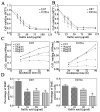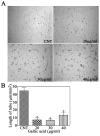Gallic acid suppresses cell viability, proliferation, invasion and angiogenesis in human glioma cells
- PMID: 20553913
- PMCID: PMC3003697
- DOI: 10.1016/j.ejphar.2010.05.043
Gallic acid suppresses cell viability, proliferation, invasion and angiogenesis in human glioma cells
Abstract
Gallic acid, an organic acid, also known as 3,4,5-trihydroxybenzoic acid, is cytotoxic against certain cancer cells, without harming normal cells. The objective of this study is to evaluate whether gallic acid can inhibit glioma cell viability, proliferation, invasion and reduce glioma cell mediated angiogenesis. Treatment of U87 and U251n glioma cells with gallic acid inhibited cell viability in a dose-dependent manner. BrdU and tube formation assays indicated that gallic acid significantly decreased glioma cell proliferation and tube formation in mouse brain endothelial cells, respectively. In addition, gallic acid decreased U87 cell invasion in vitro. Western blot analysis showed that expression of ADAM17, p-Akt and p-Erk was suppressed by gallic acid in both U87 and U251n cell lines. These data suggest that suppression of ADAM17 and downregulation of PI3K/Akt and Ras/MAPK signaling pathways may contribute to gallic acid-induced decrease of invasiveness. Gallic acid may be a valuable candidate for treatment of brain tumor.
Copyright (c) 2010 Elsevier B.V. All rights reserved.
Figures




Similar articles
-
Gallic acid reduces cell viability, proliferation, invasion and angiogenesis in human cervical cancer cells.Oncol Lett. 2013 Dec;6(6):1749-1755. doi: 10.3892/ol.2013.1632. Epub 2013 Oct 15. Oncol Lett. 2013. PMID: 24843386 Free PMC article.
-
ADAM17 promotes glioma cell malignant phenotype.Mol Carcinog. 2012 Feb;51(2):150-64. doi: 10.1002/mc.20772. Epub 2011 Apr 7. Mol Carcinog. 2012. PMID: 21480393 Free PMC article.
-
Glioma stem cell-derived exosomal miR-944 reduces glioma growth and angiogenesis by inhibiting AKT/ERK signaling.Aging (Albany NY). 2021 Jul 7;13(15):19243-19259. doi: 10.18632/aging.203243. Epub 2021 Jul 7. Aging (Albany NY). 2021. PMID: 34233294 Free PMC article.
-
Effects of Fibronectin 1 on Cell Proliferation, Senescence and Apoptosis of Human Glioma Cells Through the PI3K/AKT Signaling Pathway.Cell Physiol Biochem. 2018;48(3):1382-1396. doi: 10.1159/000492096. Epub 2018 Jul 26. Cell Physiol Biochem. 2018. Retraction in: Cell Physiol Biochem. 2020;54(6):1257. doi: 10.33594/000000317. PMID: 30048971 Retracted.
-
[The anti-cancer effect of ZR30 protein via targeting extracellular signal proteins of different cell subpopulations of glioma].Zhonghua Zhong Liu Za Zhi. 2018 Nov 23;40(11):812-817. doi: 10.3760/cma.j.issn.0253-3766.2018.11.003. Zhonghua Zhong Liu Za Zhi. 2018. PMID: 30481930 Chinese.
Cited by
-
Gallic acid exerts a protective or an anti-proliferative effect on glioma T98G cells via dose-dependent epigenetic regulation mediated by miRNAs.Int J Oncol. 2015 Apr;46(4):1491-7. doi: 10.3892/ijo.2015.2864. Epub 2015 Feb 2. Int J Oncol. 2015. PMID: 25646699 Free PMC article.
-
Antioxidant effect of gallic acid on retinal ganglion cells in glaucoma model.Sci Rep. 2024 Jun 28;14(1):14907. doi: 10.1038/s41598-024-65965-7. Sci Rep. 2024. PMID: 38942959 Free PMC article.
-
Characterization of the Interaction between Gallic Acid and Lysozyme by Molecular Dynamics Simulation and Optical Spectroscopy.Int J Mol Sci. 2015 Jul 1;16(7):14786-807. doi: 10.3390/ijms160714786. Int J Mol Sci. 2015. PMID: 26140374 Free PMC article.
-
Metabolic Reprogramming by Reduced Calorie Intake or Pharmacological Caloric Restriction Mimetics for Improved Cancer Immunotherapy.Cancers (Basel). 2021 Mar 12;13(6):1260. doi: 10.3390/cancers13061260. Cancers (Basel). 2021. PMID: 33809187 Free PMC article. Review.
-
Synthesis, antiproliferative activity and molecular properties predictions of galloyl derivatives.Molecules. 2015 Mar 25;20(4):5360-73. doi: 10.3390/molecules20045360. Molecules. 2015. PMID: 25816079 Free PMC article.
References
-
- Agarwal C, Tyagi A, Agarwal R. Gallic acid causes inactivating phosphorylation of cdc25A/cdc25C-cdc2 via ATM-Chk2 activation, leading to cell cycle arrest, and induces apoptosis in human prostate carcinoma DU145 cells. Mol Cancer Ther. 2006;5:3294–3302. - PubMed
-
- Chi A, Norden AD, Wen PY. Inhibition of angiogenesis and invasion in malignant gliomas. Expert Rev Anticancer Ther. 2007;7:1537–1560. - PubMed
-
- Faried A, Kurnia D, Faried LS, Usman N, Miyazaki T, Kato H, Kuwano H. Anticancer effects of gallic acid isolated from Indonesian herbal medicine, Phaleria macrocarpa (Scheff.) Boerl, on human cancer cell lines. Int J Oncol. 2007;30:605–613. - PubMed
-
- Kheradmand F, Werb Z. Shedding light on sheddases: role in growth and development. Bioessays. 2002;24:8–12. - PubMed
-
- Lamszus K, Brockmann MA, Eckerich C, Bohlen P, May C, Mangold U, Fillbrandt R, Westphal M. Inhibition of glioblastoma angiogenesis and invasion by combined treatments directed against vascular endothelial growth factor receptor-2, epidermal growth factor receptor, and vascular endothelial-cadherin. Clin Cancer Res. 2005;11:4934–4940. - PubMed
Publication types
MeSH terms
Substances
Grants and funding
LinkOut - more resources
Full Text Sources
Other Literature Sources
Medical
Miscellaneous

